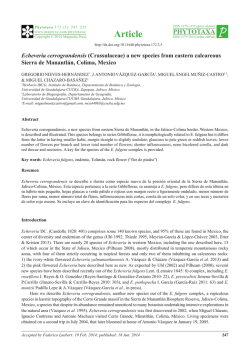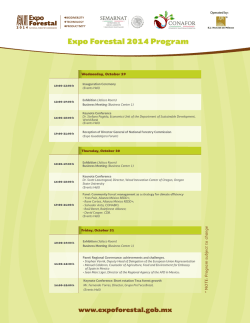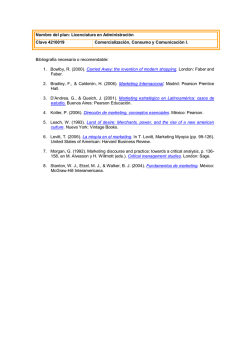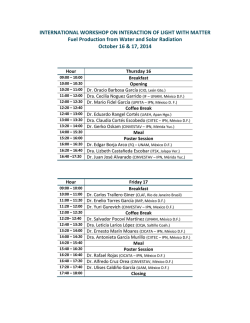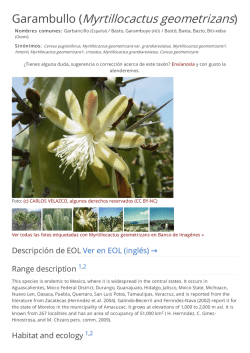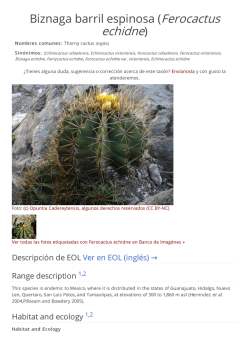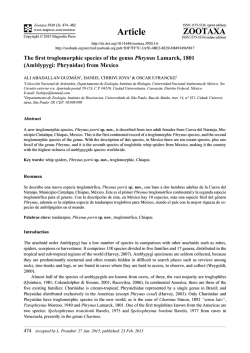
Echeveria munizii (Crassulaceae) a new species of epiphyte from
Phytotaxa 000 (0): 000–000 www.mapress.com/phytotaxa/ Copyright © 2014 Magnolia Press Article ISSN 1179-3155 (print edition) PHYTOTAXA ISSN 1179-3163 (online edition) http://dx.doi.org/10.11646/phytotaxa.00.0.0 Echeveria munizii (Crassulaceae) a new species of epiphyte from tropical Volcán de Colima, Mexico J. ANTONIO VÁZQUEZ-GARCÍA1,2,4, GREGORIO NIEVES-HERNÁNDEZ1, JESÚS PADILLA-LEPE1, ANA TERESA NUÑO-RUBIO1 AND MIGUEL CHÁZARO-BASÁÑEZ3 Herbario IBUG, Instituto de Botánica, Departamento de Botánica y Zoología, Universidad de Guadalajara-CUCBA, Zapopan, Jalisco, México 2 Investigador Prometeo - Centro de Investigación, Posgrado y Conservación Amazónica, Universidad Estatal Amazónica, km 44, Santa Clara, Napo, Ecuador. 3 Laboratorio de Biogeografía, Departamento de Geografía, Universidad de Guadalajara-CUCSH, Guadalajara, Jalisco, México 4 E-mail: [email protected], [email protected] 1 Abstract Echeveria munizii, a new species from the southwestern slopes of Volcán de Colima on the Colima-Jalisco border in western Mexico is described and illustrated. This species belongs to series Gibbiflorae and is most similar to E. fulgens from which it differs in having adaxially sulcate leaves with straight and hyaline margins, olive green to brownish green surface, a fewer flowered inflorescence with fewer flowers per branch, a pink / orange bicolored corolla with the inner surface pale pink to orange, the base of the carpels white, and longer pedicels. A species conservation assessment, undertaken using IUCN criteria, determines Echeveria munizii to be Critically Endangered (CR). Keywords: Echeveria fulgens, endemic, Comala, tropical moist forest. Resumen Echeveria munizii se describe e ilustra como especie nueva de la vertiente suroeste del Volcán de Colima, cerca de los límites de los estados de Colima y Jalisco en el occidente de México. Esta especie pertenece a la serie Gibbiflorae, difiere de E. fulgens por tener hojas sulcadas adaxialmente, margen hialino y recto, superficie verde-olivo a café-verdosa, un menor número de flores por rama, un menor número total de flores, corola bicolora de rosa a naranja en el exterior y de blanco-rosada a naranja en el interior, los carpelos blancos en la base y pedicelos más largos. Un asesoría del estado de conservación de Echeveria munizii le clasifica como en Peligro Crítico (CR) Introduction Echeveria DC. (1828: 401) comprises about 140 known species, 95 % of which are found in Mexico, the center of species diversity and endemism for the genus (Uhl 1992, Thiede 1995, Meyrán-García & López-Chávez 2003, Etter & Kristen 2013). Currently 12 species of Echeveria are recorded from Jalisco State (Pilbeam 2008). These are found mostly in temperate mountainous rocky areas. Four of the species known from Jalisco occur in tropical forest: E. pringlei (S. Watson) Rose (Britton & Rose 1903: 6), E. elegans var. tuxpanensis Walther (1972: 101), E. yalmanantlanensis A. Vázquez & Cházaro (Vázquez-García et al. 2013: 274), and the species here described. As anticipated by Uhl (2002) and Pilbeam (2008) several new species have been described recently from the E. fulgens Lem. (1845: 8) complex. These include E. roseiflora J. Reyes & O. González (Reyes-Santiago & González-Zorzano 2010: 22), E. perezcalixii Jimeno-Sevilla & P.Carrillo (Jimeno-Sevilla & Carrillo-Reyes 2010: 303), E. purhepecha I. García (García-Ruiz 2011: 63) and E. aurantiaca Reyes, González-Zorzano & Brachet (Reyes-Santiago et al. 2011: 70). Here we describe a new species from the E. fulgens complex, Echeveria munizii. E. munizii is an epiphyte occurring in the high canopy of tropical moist forest on the southwestern slopes of Volcán de Colima, Mexico. Accepted by Alex Monro: 13 Nev. 2014; published: xx xxx. 2014 Materials and Methods Fifteen qualitative and quantitative morphological characters were used to delimit species boundaries. Of these four (see diagnosis) were shared between Echeveria fulgens and E. munizii, and they differ in eleven characters (Table 1). We examined herbarium material at IBUG and digital images provided by Julia Etter and Martin Kristen.. Fieldwork was conducted in August 2012 by Miguel A. Muñiz-Castro, Jesús Padilla-Lepe and Ana T. Nuño-Rubio during which a high canopy epiphytic Echeveria was spotted that was beginning to bloom in the north of Comala, Colima, México (near Hacienda San Antonio). The plant was growing in an unusually species-rich epiphytic community of tropical moist forests confined to ravines. The caulescent habit with cymose-paniculate inflorescences and lateral circinate branches suggested a close morphological relationship to Echeveria fulgens (series Gibbiflorae (Morán 1974)), a complex that likely contains several species (Uhl 2002, Pilbeam 2008). A few months later the species was found in full bloom and on close examination of the fresh flowers (with a 20x hand-lens) we concluded that this was an undescribed species. We used current IUCN criteria to assess a conservation category for the proposed new species. TABLE 1. Differences between Echeveria munizii and E. fulgens. Characters E. fulgens E. munizii Leaves Shape obovate spatulate, concave oblanceolate to obovate, adaxially sulcate along the axis Margin Size (cm) Color Inflorescence Length (cm) Flowers per branch Total number of flowers Corolla Diameter (cm) Color Carpel color Pedicels Length (cm) undulate, not hyaline, reddish straight, hyaline, green 8–15 × 4–7 (9–)12–13 × 3–4.5 yellowish green to dark red (Lemaire, 1845); green or olive to brownish green green (Jimeno-Sevilla & Carrillo-Reyes, 2010), green to dark red ( Reyes-Santiago & González-Zorzano, 2010). ≤90 ≥12 >24 30–57 (1–)3–5 10–11 ≤1.5 bicolored, dark pink to red with yellow base, orange inside 1.0–1.1 bicolored, pink at the base (lower 1/3) to orange (upper 2/3). Pinkish white inside to orange yellow at the base, red carmine or brown toward white at the base, red carmine to dark red toward the the apex apex 0.2–0.6 0.7–0.8 Description of the new species Echeveria munizii Padilla Lepe & A.Vázquez, sp. nov. (Figs. 1 & 2) Type:—MEXICO. Colima: Carretera de Comala a la Hacienda San Antonio, 2 km antes de la Hacienda de San Antonio, tropical gallery forest, 1325 m, 19°26’21.1”N, 103°42’32.4”W, 12 October 2012 (fl), Miguel A. Muñiz-Castro, J. Antonio Vázquez-García, Jesús Padilla-Lepe 1137 (holotype IBUG; isotypes MEXU, IEB). Diagnosis:—Echeveria munizii is morphologically most similar to E. fulgens in having an evident stem, obovate leaves, erect pedicels and reniform yellow nectaries. It differs, however, in having adaxially sulcate leaves vs. concave leaves; leaf margins straight and hyaline and green vs. undulate, not hyaline and reddish; surface green or olive green to brownish green vs. yellowish green to dark red; inflorescences with a smaller number of flowers (10–11 vs. >24) and inflorescence branches bearing fewer flowers (1–)3–5 vs. • Phytotaxa 000 (0) © 2014 Magnolia Press VÁZQUEZ-GARCÍA et al. 12 or more; a corolla bicolored for its entire length (pink to orange vs. yellowish to reddish); the inner surface of the corolla pinkish white to orange vs. orange; the base of the carpels white vs. yellow and the pedicels 7–8 mm vs. 2–6 mm long (Table 1). Epiphytic perennial with lax rosette; stem solitary, erect to decumbent, 25–40 cm, 1.5 cm diam., pale brown with darker leaf scars. Rosettes 15–27.5 cm in diam., lax. Leaves (9–)12–13 × 3–4.5 cm, basally 1–1.3 cm wide, 0.4 cm thick at the midpoint, oblanceolate to obovate, cuneate at the base, concave throughout the mid vein, adaxially sulcate along the leaf axis, with evident hyaline margin when young, adaxially green to olive or brownish green, abaxially glaucous to greyish green, with a central keel, margin straight, entire, occasionally brownish dark. Floral stem solitary, erect, 30–57 cm, (including the panicle), 1 cm thick at the base, grayish green; stem leaves 1.5–5.9 × 1.5–1.6 cm, margin entire brownish green; Inflorescence cymose with 10–11 flowers in lateral circinate branches, pedicels 0.7–0.8 cm; bracteoles linear, deflexed, 0.9–2 × 0.2–0.5 cm, pinkish; sepals equal, lanceolate, straight, 1 × 0.7 cm; corolla urceolate, pentagonal at the base, 1.5 × 1.0–1.1 cm, grading from pink at the base to orange at the apex; petals 5, 1.5 × 0.6 cm, ovate, concave, acute at the apex, from pinkish at the base to orange at the apex; nectaries reniform, yellowish 0.2 × 0.1 cm; stamens with pale yellow filaments, 5 epipetalous 1 × 0.1cm and 5 antesepalous, 1.1 × 0.1cm; anthers yellowish, 0.2 cm long; gynoecium 1.3 × 0.6 cm, white at the base; pistils 1.8 × 0.3 cm, pinkish white at the base and red carmine to dark red toward the apex; stigma green to black. Distribution:—Echeveria munizii is only known from the type locality and is endemic to a southwestern slope of the Volcán de Colima complex at 1325 m, Comala municipality, Colima, Mexico. Habitat:— E. munizii grows in tropical moist forest in a small ravine together with Aphananthe monoica (Hemsl.) J. F. Leroy (1961: 74), Lysiloma acapulcense (Kunth) Benth. (1844: 83), Ficus L. (1753: 1059) sp., Trema micrantha (L.) Blume (1856: 58), Calyptropsidium sartorianum (O.Berg ) Krug & Urb. (Urban 1894: 571), Otatea (McClure & E.W. Sm.) C.E. Calderón & Soderstr. (1980: 21) sp., Croton L. (1753: 1004) sp., Stemmadenia tomentosa Greenm. (1900: 310), Coffea arabica L. (1753: 172), Piper hispidum Sw. (1788: 15), growing epiphytically on tall Aphanante monoica trees in an epiphytic community of mosses, lichens, ferns, orchids, Alsobia sp., Lycopodium L. (1753: 1100) sp., Hylocereus (A. Berger) Britton & Rose (1909: 428) sp., Opuntia Mill. (1754: no page is given) sp., Tillandsia usneoides (L.) L. (1762: 411), Fuchsia decidua Standl. (1929: 248), and Manfreda Salisb. (1866: no page is given) sp.. Phenology:—Flowering from late August to October and fruiting from October to November. Etymology:—The specific epithet honors Dr. Miguel Angel Muñiz Castro of the Universidad de Guadalajara, Jalisco, Mexico; explorer and professional devoted to the study of the ecology and conservation of cloud forests and endangered tree species of western Mexico. Ethnobotany:—There is no available information on the use of the species, however like any other succulent it has potential as an ornamental. Species conservation assessment:—E. munizii is only known from the type locality, one little ravine on a hill of the southwestern slope of Volcán de Colima complex. The habitat of E. munizii, tropical moist forest, is quickly and continuously being transformed for coffee plantations or pasture where only a few tall trees remain as shade. Its habitat is therefore small, highly fragmented and is surrounded by deforested land. The area of the forested ravines where E. munizii grows is estimated in less than 80 km2 and the known area of occupancy less than 0.4 km2. We believe that this species is in urgent need of protection, so E. munizii should be included in the IUCN Red List of Threathened Species as Critically Endangered under criteria B1,2(a,b) of the IUCN Red List Categories and Criteria (IUCN 2012): The estimated geographical range of E. munizii in the form of extent of occurrence (EOO) is <100 km2 (B1), in the form of area of occupancy (AOO) is < 10 km2 (B2); its habitat is severely fragmented by deforested land used for pasture for cattle, there is only one known location for this species [B(a)]; and there is a continuing decline observed in the extent and quality of its habitat and an estimated reduction in its area of occupancy [B(b)]. It ‘is recommended to do more exploration work to define more precisely whether this species can occur in other ravines of the southern slopes of the Volcán de Colima, so far, in this failed search to locate additional populations of this species we have found nearby another two distinct and gigantic undescribed species of Echeveria, one in the lowlands and one in the highlands of the same volacnic complex. Additional specimens examined:—MEXICO: Colima, Municipio Comala, Colima –Comala–San Antonio, curve to the left between km 19–20, 19°26’21’’N, 103°42’40’’W, 1220 m, 31 January 2003 (sterile) Etter and Kristen 945 (digital image, IBUG); Carretera de Comala a la Hacienda San Antonio, 2 km antes de la Hacienda de San Antonio, tropical gallery forest, 1325 m, 19°26’21.27”N, 103°42’31.14”W, 24 August 2012 (sterile), Muñiz-l rangCastro et al. 1130b (IBUG); same type location 19°26’21.1”N, 103°42’32.4”W, 12 October 2012 (fl) Muñiz-Castro, et al. 1139a, 1139b (IBUG). Echeveria munizii (Crassulaceae) Phytotaxa 000 (0) © 2014 Magnolia Press • FIGURE 1. A–C. flowers, D. Panicle. E. ������������������������������������������������������������������������ habit. F. habitat. G–H rosette variability. ������������������������� Drawings by Daniel Barba. • Phytotaxa 000 (0) © 2014 Magnolia Press VÁZQUEZ-GARCÍA et al. FIGURE 2. Echeveria munizii. A. Dissected flower, showing outer corolla (left), stamens and pistils (center), and nectaries (right). B. terminal flowers. C. habit. D. habitat. Photographers: J. Antonio Vázquez-García (A), Miguel A. Muñiz-Castro (B, C, D) and Adolfo Sánchez García (E). Echeveria munizii (Crassulaceae) Phytotaxa 000 (0) © 2014 Magnolia Press • Discussion:—Echeveria munizii belongs to series Gibbiflorae (Baker) A. Berger, sensu Moran (1974), a group consisting of medium to large sized stem-forming plants lacking pubescence and that have cymose-paniculate inflorescence with circinate lateral branches (Uhl 2002, Kimnach 2003, Meyrán-García & López-Chávez 2003, Carrillo-Reyes et al. 2009). This species was perhaps discovered back in 1880 by the famous plant collector Benedict Roezl, who reported in his “Ascent of the Volcán de Colima”, an epiphytic Echeveria from the SW slopes of Volcán de Colima which might correspond to E. munizii. Roezl, however, hardly ever collected specimens and so this cannot be confirmed (Roezl 1880, Roezl 1882, Hemsley 1883). After more than a century and independent of our work, Etter & Kristen collected E. munizii specimens in August 2003, but these were identified as Echeveria aff. fulgens (Etter & Kristen 2013). Acknowledgements To Daniel Barba for the drawings. To Adolfo Sánchez García of the International Society of Arborists, who climbed to the high forest canopy to collect and take pictures of Echeveria specimens “in situ”. To Enrique Sánchez Ibañez, keeper of the Garden and Greenhouses at the Instituto de Botánica of the Universidad de Guadalajara. Special thanks to the project PROMETEO-Sectretaría Superior de Ciencia, Tecnología e Inovación, of the Republic of Ecuador for the research scholarship (July2014-July 2015) granted to the firsT author. References Bentham, G. (1844) Notes on Mimoseae, with a synopsis of species. London Journal of Botany 3: 82–112 Blume, C. L. (1856) Museum Botanicum 2: 58. http://dx.doi.org/10.5962/bhl.title.274 Britton, N.L. & Rose, J.N. (1903) Botanical contributions. New or Noteworthy North American Crassulaceae. Bulletin of the New York Botanical Garden 3: 1–45. Britton, N.L. & Rose, J.N. (1909) the genus Cereus and its allies in North America Contributions from the United States National Herbarium 12: 428. Calderón, C. E. and Soderstrom, T. R. (1980) The Genera of Bambusoideae (Poaceae) of the American Continent: Keys and Comments. Smithsonian Contributions to Botany 44: 21. http://dx.doi.org/10.5479/si.0081024x.44 Candolle, A.P. (1828) Crassulaceae. In: A. P. de Candolle and A. L. P. P. de Candolle, eds. Prodromus Systematis Naturalis Regni Vegetabilis. Paris. 3: 382–414. http://dx.doi.org/10.5962/bhl.title.286 Carrillo-Reyes, P., Sosa, V. & Mort, M.E. (2009) Molecular phylogeny of the Acre clade (Crassulaceae): Dealing with the lack of definitions for Echeveria and Sedum. Molecular Phylogenetics and Evolution 53: 267–276. http://dx.doi.org/10.1016/j.ympev.2009.05.022 Etter, J. and Kristen, M. (2013) Crassulaceae. Data base. Available from: http://www.crassulaceae.com/botanik/botcrassulaceae_ en.asp?bgt=cm (Accessed: 05 February 2014). García-Ruiz, I. (2011) Nueva especie de Echeveria del centro-occidente de Michoacán, México. Revista Mexicana de Biodiversidad 82: 63–67. Greenman, J. M. (1900) New species and varieties of Mexican plants. Proceedings of the American Academy of Arts and Sciences 35: 307–315. http://dx.doi.org/10.2307/25129936 Hanstein, J.L.E.R.von. (1853[1854]) Die Gesneraceen des Königlichen Herbariums und der Gärten zu Berlin nebst Beobachtungen über die Familie im Ganzen. Linnaea 26: 207. Hemsley, W. B. (1883) Ascent of the Volcán de Colima. The Gardener´s. Chronicle II. 19: 369, 415–416. IUCN (2012). IUCN Red List Categories and Criteria: Version 3.1. Second edition. Gland, Switzerland and Cambridge, UK: IUCN. iv + 32pp. Jimeno-Sevilla, H.D. & Carrillo-Reyes, P. (2010) Echeveria perezcalixii, una especie nueva del occidente de México. Brittonia 62: 303– 308. http://dx.doi.org/10.1007/s12228-010-9137-1 • Phytotaxa 000 (0) © 2014 Magnolia Press VÁZQUEZ-GARCÍA et al. Kimnach, M. (2003) Echeveria. In: Eggli, U. (ed.) Illustrated Handbook of Succulent Plants: Crassulaceae. Springer, ������������������������� Berlin, pp.103– 128. Lemaire, A.C. (1845) Echeveria fulgens: Crassulacées & Umbilicées. Hortus Vanhoutteanus 1: 8. Leroy, J.F.P. (1961) Journal d’Agriculture Tropicale et de Botanique Appliquée 8: 74. Linnaeus, C. (1753) Species Plantarum Volume 1. Laurentius Salvius, Stockholm, pp. 1-560. Linnaeus, C. (1753) Species Plantarum Volume 2. Laurentius Salvius, Stockholm, pp. 561–1200.. Linnaeus, C. (1762) Species Plantarum, Editio Secunda 1: 411. 1762. Meyrán-García, J. & López-Chávez, L. (2003) Las Crasuláceas de México. Sociedad de Cactáceas y Suculentas Mexicanas. México, D.F., 234 pp. Miller, P. (1754) The Gardeners Dictionary...Abridged...fourth edition vol. 2, no page number given.. Moran, R. (1974) Division of genus Echeveria into series. In: Jacobsen, H. (ed.). Lexicon on succulent plants. Blandford Prees, London, pp. 184–186. Pilbeam, J. (2008) The genus Echeveria. The British Cactus & Succulent Society, Essex, 333 pp. Reyes-Santiago, J. & González-Zorzano, O. (2010) Echeveria roseiflora (Crassulaceae) una nueva especie para el estado de Jalisco, México. Cactáceas y Suculentas Mexicanas. 55: 19–26. Reyes-Santiago, J., González-Zorzano, O. & Brachet Ize, C. (2011) Echeveria aurantiaca (Crassulaceae), una nueva especie del estado de Guerrero, México. Cactáceas y Suculentas Mexicanas. 56: 68–74 Roezl, B. (1882) Mon dernier voyage à la côte occidentale du Mexique. Belgique Horticole 32: 68–113. Roezl, B. (1880) Meineletzte Reise an der Westküste von Mexiko. Deutsche Gaertner-Zeitung 4: 11–12, 34–36, 58–60, 78–79, 105–108, 129, 131, 154–155, 180–181, 227. Salisbury, R. A. (1866) The Genera of Plants 78. http://dx.doi.org/10.5962/bhl.title.10314 Standley, P. C. (1929) Publications of the Field Museum of Natural History, Botanical Series 4: 248. Swartz, O. (1788) Nova Genera et Species Plantarum seu Prodromus 158 pp. http://dx.doi.org/10.5962/bhl.title.4400 Thiede J. (1995) Quantitative phytogeography, species richness, and evolution of American Crassulaceae. In: Hart H’t, Eggli, U. (eds.). Evolution and systematics of the Crassulaceae. Leiden: Backhuys Publishers, pp. 89–123. Uhl, C.H. (1992) Polyploidy, dysploidy and chromosome pairing in Echeveria (Crassulaceae) and its hybrids. American Journal of Botany 79: 556–566. http://dx.doi.org/10.2307/2444868 Uhl, C.H. (2002) Chromosomes and hybrids of Echeveria (Crassulaceae). VII. Series Gibbiflorae (Baker) Berger. Haseltonia 9: 121– 145. Urban, I. (1894). Additamenta ad cognitionem florae indiae occidentalis. Botanische Jahrbücher für Systematik, Pflanzengeschichte und Pflanzengeographie 19: 562-576. Vázquez-García, J.A., Jimeno-S., D., Cuevas-Guzmán, R., Cházaro-B., M.J. & Muñiz-Castro, M.A. (2013) Echeveria yalmanantlanensis (Crassulaceae) a new species from Cerro Grande, Sierra de Manantlán, western Mexico. Brittonia 65: 273–279. http://dx.doi.org/10.1007/s12228-012-9274-9 Walther, E. (1972) Echeveria. California Academy of Sciences. San Francisco, California, 426 pp. Echeveria munizii (Crassulaceae) Phytotaxa 000 (0) © 2014 Magnolia Press •
© Copyright 2026
